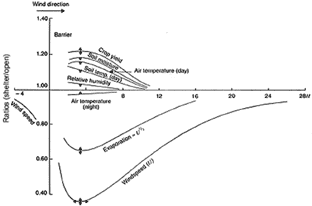|
Effect Of Shelterbelts On Microclimate
While the principle effect of a shelterbelt is on the pattern
of wind speed and turbulence, other important effects include
the alteration of radiation and the energy balances of crops.
The effect on microclimate is the sum of many elements, all
of which interact, influencing crop growth and production.

Reference: Marshall, J.K. (1967), 'The
effect of shelter on the productivity of grasslands and field
crops', Field Crop Abstracts, Vol. 20, pp 1-14.
Compared to unsheltered microclimates, some of the measured
effects include:
• Higher daytime temperatures and lower evening temperatures.
• Higher relative humidity and slightly lower CO2 during
the day.
• Higher soil and plant surface temperatures.
• Solar radiation reductions up to 1 to 2H due to shading.
• Reduction in rainfall reaching the ground within 1H
of the windbreak due to interception by the trees.
• Significant reductions in evaporation to a distance
of 10-12H due to reduced wind speeds.
• Higher concentrations of soil moisture although this
is eventually used up by the crop.
Despite the fact that the trees clearly influence wind speeds
for more than 20 times the height of the belt, many of these
microclimatic effects only occur within the first 7 or 8 shelterbelt
heights. This observation is explained by the pattern of turbulence
that results in a "quiet" and a "wake"
zone.
The Quiet And The Wake Zone
.gif)
Reference: McNaughton, K.G. (1988), 'Effects
of Windbreaks on Turbulent Transport and Microclimate', Agriculture
Ecosystems and Environment, Vol. 22/23, pp 17-40
The area downwind of a windbreak can be divided
into two distinct zones. The first is the triangular quiet
zone extending from the top of the windbreak to approximately
8H for perpendicular winds under stable conditions with low
surface roughness. Within this zone the size of the eddies
(air turbulence) is small. The other distinct zone or wake
zone is an area of more energetic and larger turbulence structures,
resulting from the wind being compressed and accelerated over
the windbreak and then dissipating downwind.
The degree of mixing of the air above the crop is thought
to explain the microclimatic observations. In the quiet zone
a layer of moist, warm air is able to develop above the crop
whereas in the wake zone this is lost due to greater mixing
of air.
Variation of surface temperature between the 'quiet' and 'wake'
zones.
.gif)
Reference: McNaughton, K.G. (1988), 'Effects of Windbreaks
on Turbulent Transport and Microclimate', Agriculture Ecosystems
and Environment, Vol. 22/23, pp 17-40
Back to top
|
